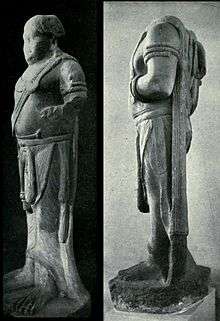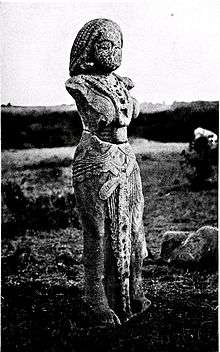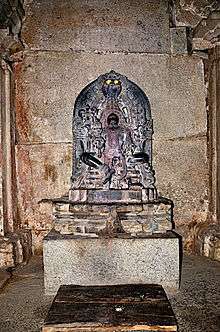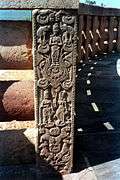Yaksha
.jpg)
Yaksha (Sanskrit यक्ष yakṣa, Odia-ଯକ୍ଷ, Pali yakkha)[1] is the name of a broad class of nature-spirits, usually benevolent, who are caretakers of the natural treasures hidden in the earth and tree roots.[2] They appear in Hindu, Jain and Buddhist texts.[2] The feminine form of the word is yakṣī[3] or Yakshini (yakṣiṇī).[4]
In Hindu, Jain, and Buddhist texts, the yakṣa has a dual personality. On the one hand, a yakṣa may be an inoffensive nature-fairy, associated with woods and mountains; but there is also a darker version of the yakṣa, which is a kind of ghost (bhuta) that haunts the wilderness and waylays and devours travelers, similar to the rakṣasas.
In Kālidāsa's poem Meghadūta, for instance, the yakṣa narrator is a romantic figure, pining with love for his missing beloved. By contrast, in the didactic Hindu dialogue of the Yakṣapraśnāḥ "Questions of the Yakṣa", it is a tutelary spirit of a lake that challenges Yudhiṣṭhira. The yakṣas may have originally been the tutelary gods of forests and villages, and were later viewed as the steward deities of the earth and the wealth buried beneath.
In Indian art, male yakṣas are portrayed either as fearsome warriors or as portly, stout and dwarf-like. Female yakṣas, known as yakṣiṇīs, are portrayed as beautiful young women with happy round faces and full breasts and hips.
Early Yakshas
Several monumental Yashas are known from the time the Mauryan Empire period. They are variously dated from around the 3rd century BCE to the 1st century BCE. These statues are monumental (usually around 2 meters tall), and often bear inscriptions related to their identification as Yakshas. They are considered as the first known monumental stone sculptures in India. Two of these monumental Yakshas are known fron Patna, one from Vidisha and one from Parkham, as well as one female Yashi from Besnagar.
 The two Yakshas discovered in Patna, ancient Pataliputra.
The two Yakshas discovered in Patna, ancient Pataliputra.
 Modern photograph of the Parkham Yaksha.
Modern photograph of the Parkham Yaksha.
Yakṣas in Buddhism

In Buddhist literature, the yakṣa are the attendants of Vaiśravaṇa, the guardian of the northern quarter, a beneficent god who protects the righteous. The term also refers to the Twelve Heavenly Generals who guard Bhaiṣajyaguru, the Medicine Buddha.
According to the Mahavamsa, Prince Vijaya encountered the royalty of the yakkhas' queen, Kuveni, in her capital of Lankapura, and conquered them. The Yakkhas served as loyal subjects with the House of Vijaya and the yakkha chieftain sat on equal height to the Sri Lankan leaders on festival days.
Yak in Thailand
Yakshas (Thai: ยักษ์, Yak) are an important element in Thai temple art and architecture.[5] They are common as guardians of the gates in Buddhist temples throughout the country since at least the 14th century. Ceramic sculptures of guardian Yakshas were produced in Thailand, during the Sukhothai and Ayutthaya periods, between the 14th and 16th centuries, at several kiln complexes in northern Thailand.[6] They are mostly depicted with a characteristic face, having big round bulging eyes and protruding fangs, as well as a green complexion. Yakshas and their female counterparts are common in the Buddhist literature of Thailand, such as in the The Twelve Sisters and Phra Aphai Mani. As ogres, giants, and ogresses, yakshas are present as well in Thai folklore.
"ย ยักษ์", (yo yak) is also used as an illustration in order to name the letter ย, the 34th consonant of the Thai alphabet, according to the traditional letter symbols Thai children use to memorize the alphabet.[7]
Yaksha and Yakshini in Jainism
Jains mainly worship idols of Arihants and Tirthankaras, who have conquered the inner passions and attained God-consciousness status. Yaksha and Yakshini are found in pair around the idols of Jinas as guardian deities. Yaksha is generally on the right-hand side of the Jina idol and Yakshini on the left-hand side. In earlier periods, they were regarded mainly as devotees of Jina, and have supernatural powers. They are also wandering through the cycles of births and deaths just like the worldly souls, but have supernatural powers. Over time, people started worshiping these deities as well.[8]
Jainism provides very clear foundations and guidelines, and it is up to every individual Jains to decide which idols to worship and which ones that should just be acknowledged. Sthanakvasi and Terapanthi Jains of the Svetambara and Taranpanthi Jains of the Digambaras do not believe in idol worshiping.
Yaksha in Jainism

In Jainism, there are twenty-four yakshas for twenty-four tirthankaras:[9]
- Gomukha
- Mahayaksha
- Trimukha
- Yaksheshvara or Yakshanayaka
- Tamburu
- Kusuma
- Varanandi or Matanga
- Vijaya or Shyama
- Ajita
- Brahma or Brahmeshvara
- Ishvara or Yakset
- Kumara
- Shanmukha or Karttikeya
- Patala
- Kinnara
- Kimpurusha or Garuda
- Gandharva
- Kendra or Yakshendra
- Kubera
- Varuna
- Bhrikuti
- Gomedh or Sarvahna
- Dharanendra or Parshvayaksha
- Matanga
Images
_Brahma_image_in_the_mantapa_in_the_Jain_temple_at_Lakkundi.jpg) Brahmeshvara image at Jain Temple, Lakkundi, 11th century CE
Brahmeshvara image at Jain Temple, Lakkundi, 11th century CE Yaksha couple standing on lotus leaves, the male (sic) holding a lotus bud and posed in shalabhanjika
Yaksha couple standing on lotus leaves, the male (sic) holding a lotus bud and posed in shalabhanjika- Dvarapala Yaksha made of basalt. Statue found in Buddhist cave (Pitalkhora) and dates to 2nd century CE. On display in the Prince of Wales Museum.
See also
Notes
- ↑ For yakkha as a "rare use in Pali" see Franklin Edgerton, Buddhist Hybrid Sanskrit Grammar and Dictionary, vol. 2., Motilal Banarsidass, First Edition, 1953, p. 442.)
- 1 2 "yaksha". Encyclopædia Britannica. Retrieved 2007-07-15.
- ↑ For यक्षी as the feminine of यक्षः see V. S. Apte, The Practical Sanskrit-English Dictionary, p. 776.
- ↑ For yakṣiṇī (यक्षिणी) as a regular Sanskrit term for a female yakṣa, and yakṣaṇī as a Buddhist variant, see Franklin Edgerton, Buddhist Hybrid Sanskrit Grammar and Dictionary, vol. 2., Motilal Banarsidass, First Edition, 1953, p. 442.
- ↑ Thai temples
- ↑ Samuel P. Harn Museum of Art, Gainesville, Florida
- ↑ Thai alphabet in Letters
- ↑ Pramodaben Chitrabhanu, Jain symbols, Ceremonies and Practices
- ↑ http://www.jaindharmonline.com/tirthan/tirsum.htm
References
| Wikimedia Commons has media related to Yaksha. |
- Dictionary of Hindu Lore and Legend (ISBN 0-500-51088-1) by Anna Dhallapiccola
- Encyclopædia Britannica: Yaksha, EBC: Yaksha
